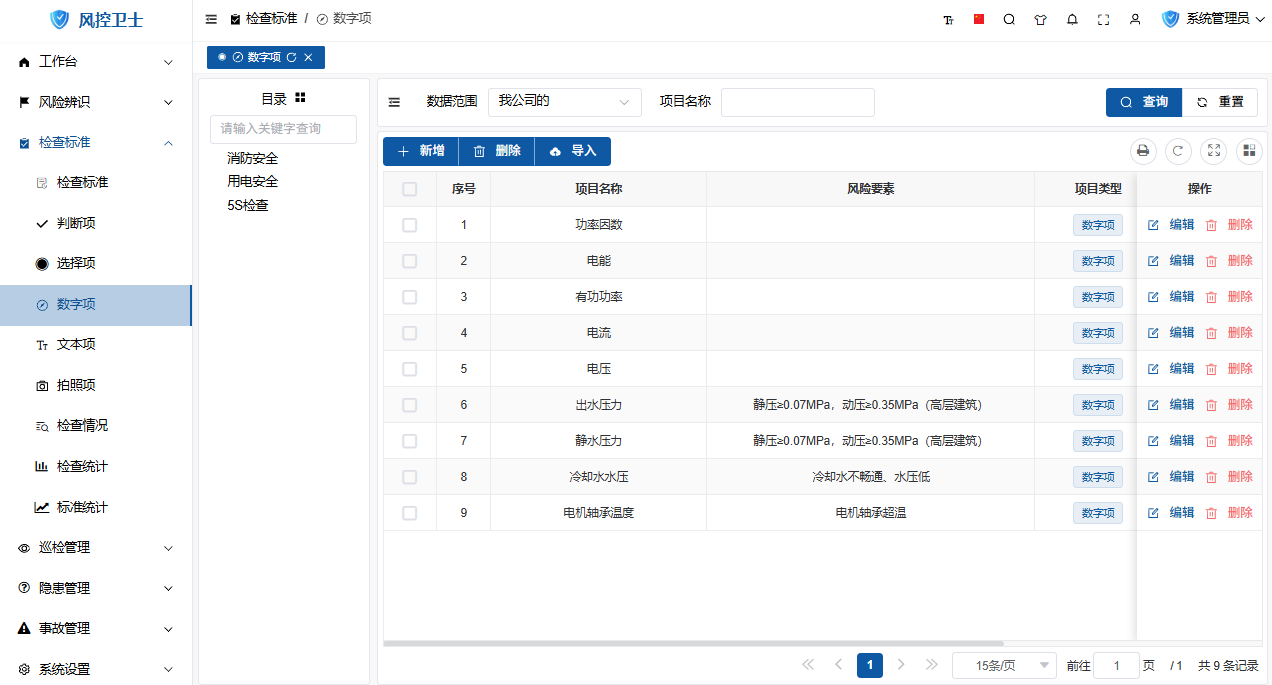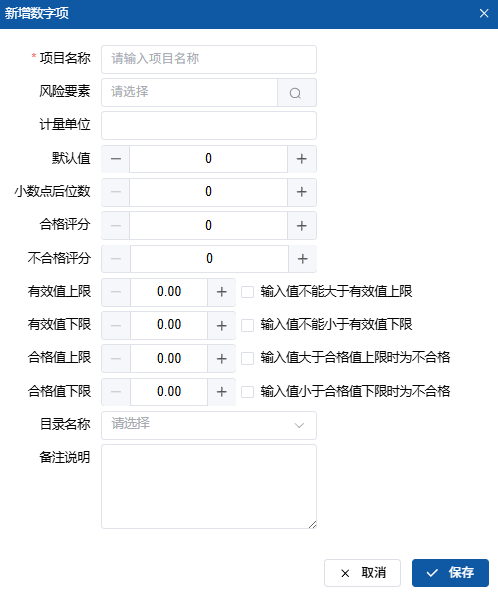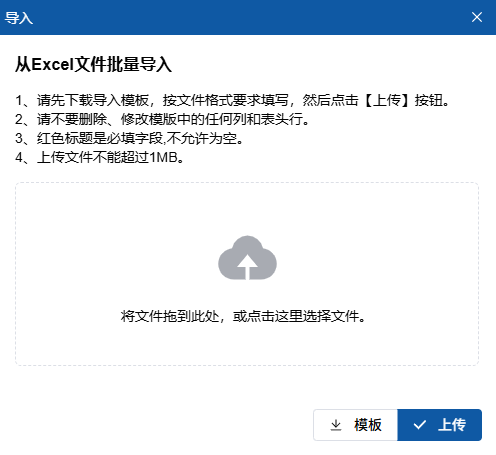How to Manage Digital Items
About 578 wordsAbout 2 min
I. Function Introduction
Digital items are standardized inspection units for numerical value entry, supporting:
- Numerical Entry: Precise input of measurement values
- Range Validation: Define qualified and valid value ranges
- Unit Management: Support multiple measurement units
- Risk Assessment: Automatically calculate risk levels
Core Value:
- Standardize numerical recording processes
- Ensure data accuracy
- Automatically determine qualified status
- Support trend analysis
Access Entry:
- Administrator logs into management backend
- Navigation menu select: 【Inspection Standards】→【Digital Items】

II. Add Digital Items
1. Single Addition
Operation Steps:
- Click "New" button on toolbar

- Fill in key information:
- Basic Information:
- Item Name (Required, e.g. "Voltage Measurement")
- Measurement Unit (e.g. "V")
- Decimal Places (0-4 digits)
- Range Settings:
- Qualified Value Lower Limit
- Qualified Value Upper Limit
- Valid Value Lower Limit
- Valid Value Upper Limit
- Risk Assessment:
- Risk Factor (Associated risk type)
- Qualified Score
- Unqualified Score
- Default Values:
- Default Numerical Value
- Category Name (Classification management)
- Basic Information:
- Click "Save" to complete creation
2. Batch Import
Operation Steps:
- Click "Import" button on toolbar

- Download Excel template

- Fill according to specifications:
- Item Name
- Measurement Unit
- Decimal Places
- Qualified Range (Min/Max)
- Valid Range (Min/Max)
- Risk Factor Code
- Scores
- Upload file and verify
- Process import results
Template Specifications:
| Column Name | Requirement | Example |
|---|---|---|
| Item Name | Unique, non-repeatable | Temperature Detection |
| Measurement Unit | Standard unit symbol | ℃ |
| Decimal Places | 0-4 | 1 |
| Qualified Value Lower Limit | Numerical value | 18.0 |
| Qualified Value Upper Limit | Numerical value | 25.0 |
| Valid Value Lower Limit | Numerical value | 10.0 |
| Valid Value Upper Limit | Numerical value | 40.0 |
| Risk Factor | Existing code | TEMP_001 |
| Qualified Score | 0-10 points | 0 |
| Unqualified Score | 0-10 points | 5 |
III. Modify Digital Items
Operation Steps:
- Locate target digital item
- Click "Edit" button in operation column
- Modify:
- Basic information (Name/Unit)
- Range settings (Qualified/Valid range)
- Risk assessment (Factor/Scores)
- Click "Save" to submit
Precautions:
- Range setting modifications require revalidation of historical data
- Core digital items require approval for modification
- Unit changes need synchronization with associated items
IV. Delete Digital Items
Operation Steps:
- Locate target digital item
- Click "Delete" button in operation column
- Confirm deletion operation
Restrictions:
- Cannot delete if referenced in inspection standards
- Cannot delete if historical records exist
- System core items are protected
V. Best Practices
1. Design Principles
- Naming Conventions:
- Name ≤10 characters
- Include measurement object (e.g. "Pressure Value")
- Avoid ambiguous expressions
- Range Settings:
- Qualified range ⊆ Valid range
- Valid range should cover extreme values
- Set reasonable tolerance
- Unit Management:
- Use international standard units
- Avoid unit conversion
- Specify unit symbols clearly
2. Application Scenarios
| Scenario Type | Digital Item Example | Unit | Qualified Range | Valid Range |
|---|---|---|---|---|
| Electrical Testing | Voltage Measurement | V | 220±5% | 0-250 |
| Environmental Monitoring | Temperature Detection | ℃ | 20-25 | -10-50 |
| Pressure Testing | Pipeline Pressure | MPa | 0.8-1.2 | 0-2.0 |
| Level Monitoring | Water Tank Level | m | 1.5-2.0 | 0-3.0 |
VI. Precautions
1. Design Standards
- Range Validation:
- Qualified range must be within valid range
- Valid range should consider sensor measurement range
- Data Precision:
- Decimal places should match instrument precision
- Avoid excessive precision (≤4 digits)
- Risk Assessment:
- Mild exceedance: 1-3 points
- Moderate exceedance: 4-6 points
- Severe exceedance: 7-10 points
2. Data Security
- Range modifications require dual confirmation
- Modification records permanently audited
- Exceedance data automatically alerted
3. Performance Optimization
- ≤10 digital items per inspection form
- Avoid complex calculation formulas
- Maintain unit consistency to avoid conversion
